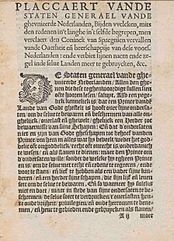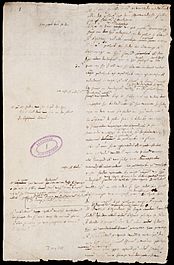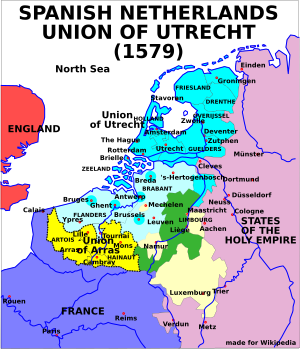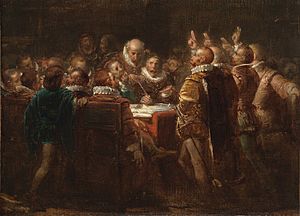Act of Abjuration facts for kids
Quick facts for kids Act of Abjuration |
|
| [[image:
|190px|]] |
|
| Ratified | 26 July 1581 |
| Authors | Andries Hessels Jacques Tayaert Jacob Valcke Pieter van Dieven Jan van Asseliers |
| Purpose | Declaration of independence of the Dutch Republic |
The Act of Abjuration (also known as Plakkaat van Verlatinghe in Dutch) was like a declaration of independence for many parts of the Netherlands. It officially ended their loyalty to Philip II of Spain, who was their ruler at the time. This important document was signed on 26 July 1581 in The Hague.
The Act stated that all leaders in the provinces that formed the Union of Utrecht no longer had to obey King Philip. The main reason given was that Philip had not been a good ruler. He had treated his people unfairly and taken away their old rights. Because of this, the Act said Philip had lost his right to be king over these provinces.
After the Act of Abjuration, these newly independent areas could govern themselves. At first, they tried to find a new king. But when that didn't work out, the provinces decided to become a republic in 1588. During this time, some parts of the Netherlands were taken back by Spain.
Why the Netherlands Broke Away
Before this, the Seventeen Provinces of the Netherlands were ruled by the same person, first Emperor Charles V, and then his son, King Philip II of Spain. Each province had its own rules and traditions. Even though they had a shared meeting called the States General of the Netherlands, they were not one single country.
Starting in 1568, several of these provinces began to rebel against Philip II. This was the start of the Dutch Revolt. At first, the rebels didn't want to fight the king directly. They said they were only fighting against his helpers, like the Duke of Alba. They wanted to get back their "ancient privileges and liberty."
However, this idea became harder to believe as the fighting continued. The States General even appointed Archduke Matthias, Philip's nephew, as a new leader without Philip's permission. Matthias was young and didn't have much power. This led to problems when some southern provinces formed the Union of Arras to stay loyal to Spain, while the northern provinces formed the Union of Utrecht to continue the rebellion.
William the Silent, a key leader of the Dutch Revolt, realized they needed a strong ally. He hoped Francis, Duke of Anjou, the brother of the French king, could help. The rebel States General offered him the chance to become their new ruler.
The Act of Abjuration is Signed
Transferring power was tricky because many local leaders had sworn loyalty to King Philip. In those days, promises of loyalty were taken very seriously. The rebel States General decided on 14 June 1581 to officially declare Philip's throne empty. They called it the "Placard of Desertion" (Plakkaat van Verlatinghe). This meant Philip had "deserted" his people, not the other way around.
A group of four people helped write the Act of Abjuration. These included Andries Hessels, Jacques Tayaert, Jacob Valcke, and Pieter van Dieven. The Act made it illegal to use Philip's name or symbols in any official business or on coins. It also said that all local leaders no longer had to be loyal to Philip. Instead, they had to swear a new oath of loyalty to the States of their own province. Jan van Asseliers, a secretary for the States General, is thought to have written the final version.
The Act of Abjuration had a very long introduction. This part explained in detail why King Philip was being removed from power. It listed all the ways he had failed his people. This style of writing, where a list of complaints is used to justify a big decision, is similar to the American Declaration of Independence. Some historians believe the American document might have been inspired by the Act of Abjuration.
The ideas behind the Act were based on the belief that a ruler must protect their subjects. If a ruler harms their people, the people have the right to remove them. This was a very new and bold idea at the time. The Act mentioned several provinces that were part of this declaration, including Brabant, Guelders, Flanders, Holland, Zeeland, Frisia, Mechelen, and Utrecht.
What Happened Next
The Act of Abjuration didn't immediately solve all the problems in the Netherlands. King Philip, of course, did not accept it. He had already declared William the Silent an outlaw and offered a reward for his capture. Many local leaders refused to take the new oath and chose to resign instead.
The Duke of Anjou, who was supposed to be the new ruler, wasn't happy with his limited power. He tried to take control of several cities, including Antwerp. His attack on Antwerp, known as the French Fury, failed badly. This made him lose all trust from the Dutch.
Because of this, the States General started looking for a different ruler again. They tried to get Elizabeth I of England to become their queen, but she refused. Then, William the Silent was asked to become the Count of Holland. However, he was assassinated in 1584 before this could happen.
After more attempts to find a monarch, the States General decided to take power themselves. This decision led to the creation of the Dutch Republic, where the seven United Provinces governed themselves without a king.
See Also
 In Spanish: Acta de abjuración para niños
In Spanish: Acta de abjuración para niños





